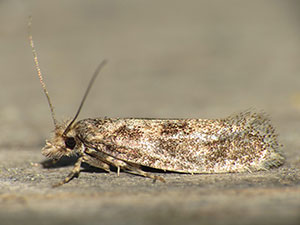How Can I Protect My Clothes From Clothes Moths?
By Chris Williams on July 23, 2014.
I read somewhere that mothballs don’t really work to protect your clothes from moths. I’ve had a problem in the past with holes in my stored sweaters and wool blazers. What else can I use?–T. Y., Melrose, MA
Mothballs Are Rarely Used As Intended
 It’s not that mothballs don’t work against clothes moths, it’s just that they don’t work in the way that we use them. Mothballs (or moth cakes or crystals) are fumigant pesticides (naphthalene or paradichlorobenzene) that volatilize, slowly changing to a gas. Unless that gas is maintained at a high enough level for a period of time in an enclosed space, it will dissipate and have little effect.
It’s not that mothballs don’t work against clothes moths, it’s just that they don’t work in the way that we use them. Mothballs (or moth cakes or crystals) are fumigant pesticides (naphthalene or paradichlorobenzene) that volatilize, slowly changing to a gas. Unless that gas is maintained at a high enough level for a period of time in an enclosed space, it will dissipate and have little effect.
To work effectively, mothballs have to be used in sufficient amounts and used in an airtight container (not a cardboard box). Most people fail on both counts. Mothballs should also never be used in open containers or in a way that will allow the pesticide fumes to accumulate in living spaces where people and pets can breathe them, which can be harmful.
We rarely read the mothballs’ label to see just how much product we should use. Almost everyone uses less than necessary to repel clothes moths. We just throw a handful in the box. And most people pack their clothes away in cardboard boxes. Even sealed cardboard boxes are not airtight enough. Plastic tubs with tight lids or zip lock bags are better choices for protecting woolens and clothing from pests.
If you’re thinking that a cedar chest or cedar chips might be an alternative repellent, think again. Studies have shown that cedar doesn’t protect woolens either, for the same reasons: not high enough concentrations and less than airtight containers. See “Does Cedar Repel Clothes Moths?”
Proper Preparation is the Most Important Protective Step
The two most important things you can do to protect stored woolens is to (1) clean them before storage, and (2) store them in airtight containers with tight-fitting lids.
Clothes moth larvae (also carpet beetle larvae and silverfish) prefer to feed on soiled clothes and woolens. Clothing that has food stains, perspiration, urine, or other bodily fluids is most likely to be damaged by fabric pests. Clean your clothes and woolens before you store them. Commercial dry cleaning also kills all stages of clothes moths. Some experts say that cleaning your woolens and storing them in the proper containers is more effective at preventing clothes moths than using mothballs or any other repellent.
There is no guarantee that your clothes will be protected, even if you do everything right. Woolens that are stored away for an extended period are more likely to become infested. If you can, periodically remove your stored woolen items, brush them to remove any clothes moth eggs and larvae, and air them outside before returning them to storage and replacing mothballs, if needed.
If you already have a fabric pest problem, you should have an exterminator inspect and treat your closets or other areas where you store woolens. There may be clothes moth eggs that are reinfesting your stored items, or the pests may be carpet beetles instead.
By Donald Hobern from Copenhagen, Denmark (Ateliotum insulare) [CC-BY-2.0], via Wikimedia Commons